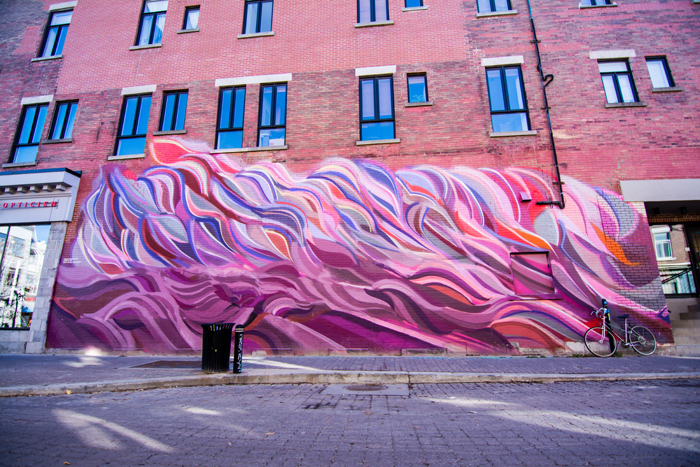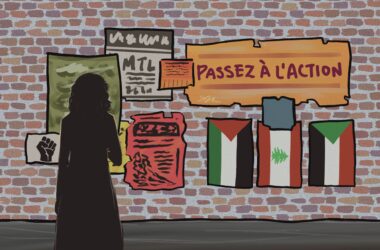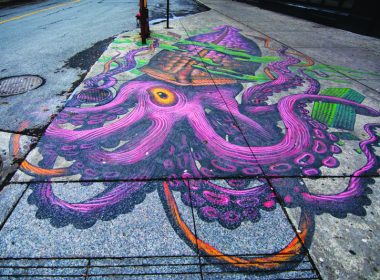Anyone who has spent enough time in Montreal—especially strolling through the peaceful tree-lined streets of the Plateau Mont-Royal, or past the busy storefronts on Blvd. St-Laurent—is bound to have seen their fair share of murals. Murals are so abundant in Montreal that after living in the city for some time, they may even fade into the background. But, there’s simply no way of missing Philippe Mastrocola’s mural on Rue St-Denis. Over 20 feet high and painted in vibrant shades of pink, red, and purple, the abstract mural on the corner of Rue St-Denis and Avenue Duluth immediately catches the eye.
For the past 13 years, Montreal-based artist Mastrocola has experimented with different forms and mediums of street art. Starting with graffiti, he has since gravitated towards mural painting, and more recently, pinhole photography. Mastrocola describes his artistic progression as an entirely organic process in which he is constantly attempting to find new mediums through which to experiment with the world of street art.
Mastrocola’s creative process in painting murals follows a path of spontaneity. In the case of the Avenue Duluth mural, titled Martine after his late cousin, the wall had been recently vacated and the bricks painted red before he contacted its owners asking for permission to create a work of art on its surface. It took him seven days to paint the mural on a ladder, using a striking palette inspired by his surroundings.
“The positivity that comes from putting colour on the wall is far too often overlooked and the simplicity of it is unbelievable,” Mastrocola said. “I’ve often seen it that people are in complete awe of the transformation of a place with the simple addition of colour.”
The vibrant colours of the mural, along with its size and traffic-heavy location, have garnered recognition for Mastrocola in the Montreal community.
“[The mural on Rue St-Denis] gets the most visibility out of any of the murals that I’ve painted,” Mastrocola explained. “And [it] has definitely helped me get my foot in the door [and get recognition as an] up-and-coming Montreal artist.”
The accessibility of his murals is not only key to the evolution of the Mastrocola’s career, but is also central to his vision of art as something that should not be regulated. Mastrocola is motivated to create murals by his desire to interact with a larger public and to contribute to the accessibility of art.
“There’s such a disconnect between the types of people who go to [museums] and those who don’t,” Mastrocola said. “Art doesn’t really belong in galleries and museums. It shouldn’t be contained, but rather, out in the real world.”
Street art’s inherent visibility does, however, have its pitfalls. In being completely accessible and visible to anyone, murals are often a target for vandalism. The wall on Avenue Duluth was made available to Mastrocola because three large chrome graffitis had been painted over the mural that was previously there. In the four years since Mastrocola painted Martine, it has been tagged with the initials of other artists 45 times, requiring him to touch up his work on each occasion that it is vandalized. Mastrocola sees a profound tension between muralists—or street artists—and graffiti artists. This tension is rooted in the issue of publicity and artistic recognition.
“Graffiti automatically involves writing your name and trying to spread that name across the city on any surface available to you,” Mastrocola explained. “Graffiti artists interact among themselves and often you can’t read those interactions. Street artists, however, try to touch everybody—all ages, all genders, all races. You’re speaking with colour on a wall. It’s a universal language.”
This rivalry between graffiti artists and street artists has shaped the evolution of Mastrocola’s career, especially in the four years since the creation of his mural on Avenue Duluth. The antagonism between the two groups influences the Montreal street art scene, especially in its relation to the public nature of mural art. Street art’s basis in visibility is therefore both its founding concept and perhaps also its largest obstacle.
Ultimately Mastrocola feels that street art and its highly visible nature have a duty to fulfill. Its place in the scenery of Montreal modifies the cityscape in a way he hopes is positive.
“Street art [revolves around] the fact that you’re painting art on a façade that would otherwise remain gray,” Mastrocola said. “We live in a city, where you’re forced to see obstructions and bland surfaces. Doing something creative on those surfaces offers a break from city life and its concrete jungle.”
A previous version of this article incorrectly stated that Philippe Mastrocola had been experimenting with different mediums of street art for the past seven years, and that his mural, 'Martine,' stands at over 10 feet high. Mastrocola has been experiementing with different mediums of street art for the past 13 years, and his mural, 'Martine,' stands at over 20 feet high.








